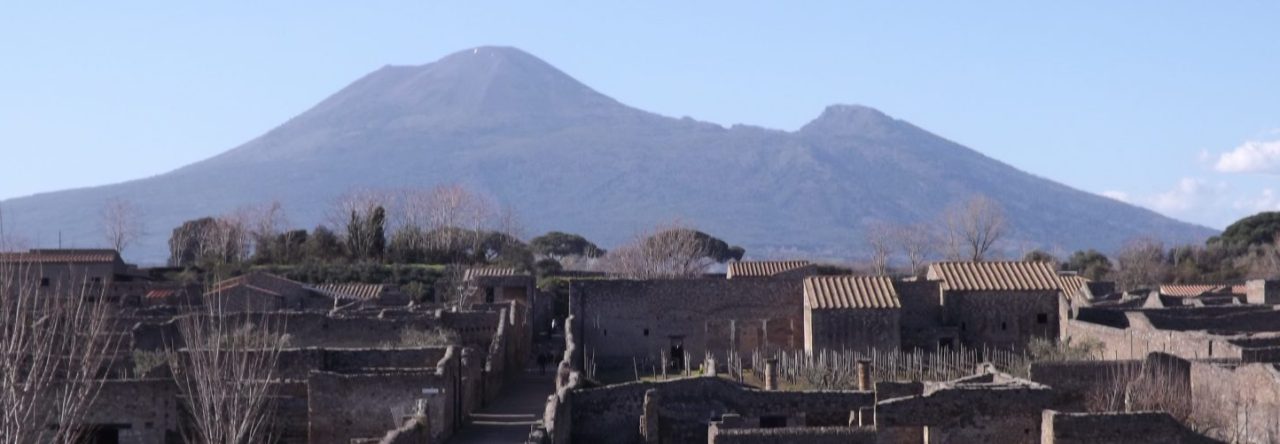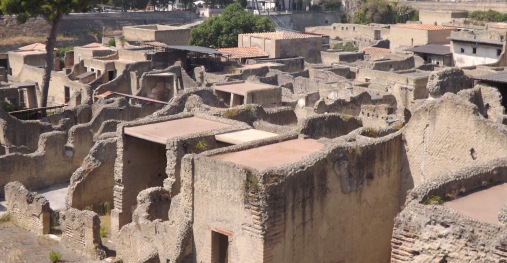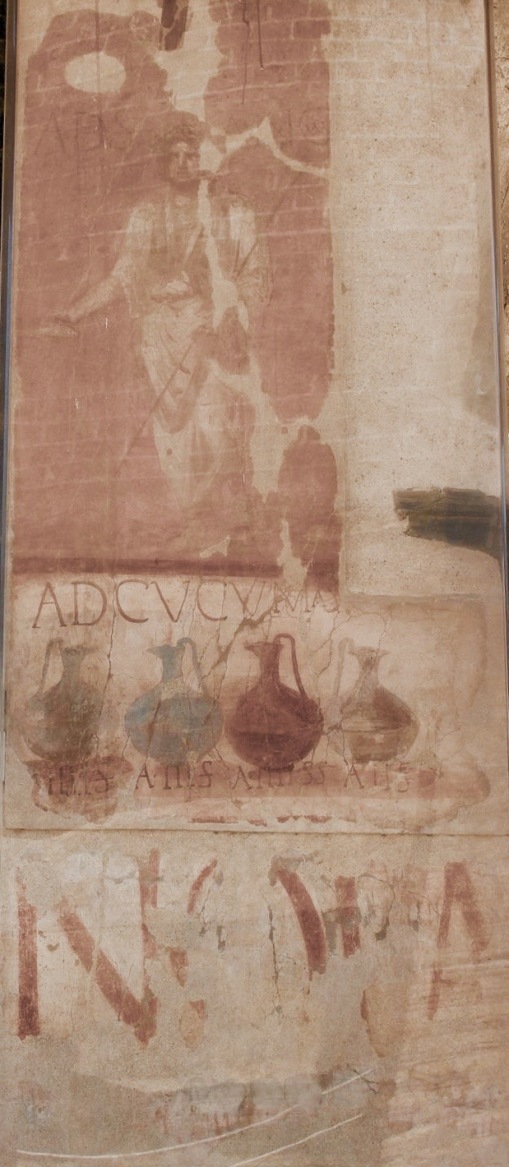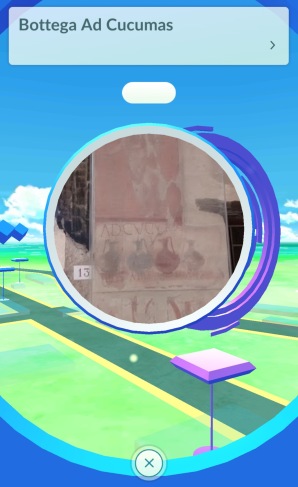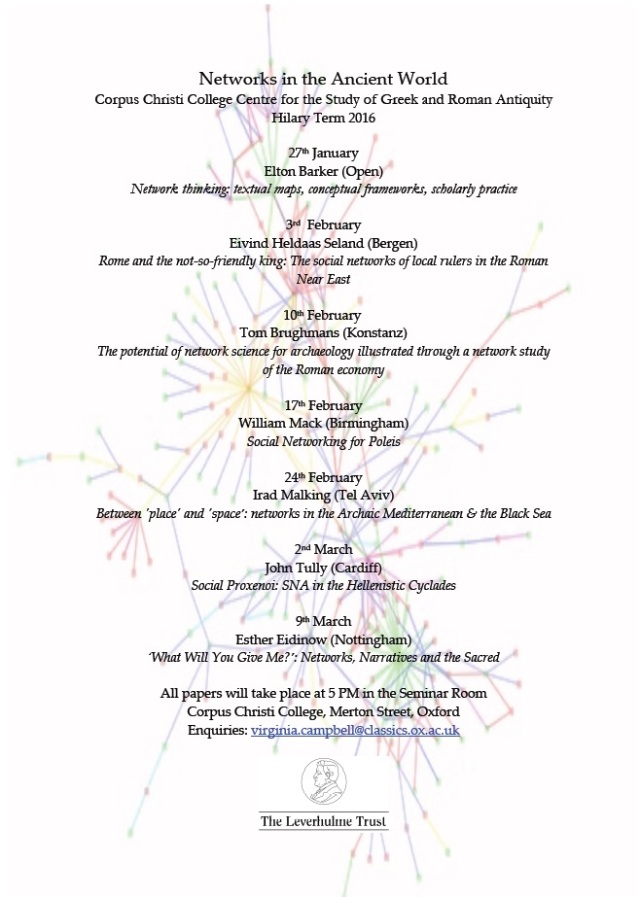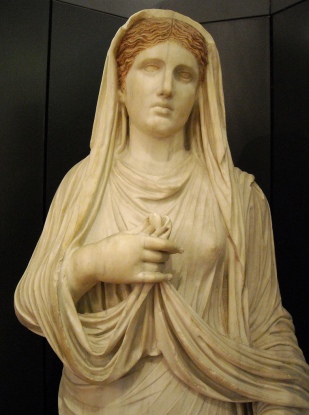
An exhibit at the Leighton House Museum, ‘A Victorian Obsession,’ prompted some discussion on Twitter* a few months ago about the content of one of Laurence Alma Tadema’s Pompeian paintings, An Exedra (1869). I have finally had the chance to see the exhibit myself, and for the first time, see in person a work of art that I have long had an affection for due to its subject matter. What suddenly struck me anew about this painting is the way in which Alma Tadema included not just the two families whose funerary texts are depicted in the tableau, but that he also added a third, thus creating a connection between three important figures (families) in Pompeian history, Marcus Porcius, Mammia, and a Marcus Holconius. (For the point of clarification, another tomb is visible in the background, that of the Istacidii, but there is no text included in the painting that identifies it as such).
The setting for the painting is the schola, or bench tomb, of a woman named Mammia, a public priestess and benefactor of the town who is known from two inscriptions. Her family is attested from pre-colonial Pompeii (VE 32) and other areas of Campania. The first text is her epitaph, carved directly into the rear of the bench depicted in this painting, which sits on the southern side of the Via dei Sepolcri just outside of the Porta di Ercolano:
CIL X 998 = ILS 6369
Mam(m)iae P(ubli) f(iliae) sacerdoti publicae locus sepultur(ae) datus decurionum decreto.
‘To Mammia, daughter of Publius, public priestess, the place of this tomb was given by decree of the decurions.’
The second, found in an unfortunate fragmentary state in the Forum has garnered much debate as a result of missing bits of text, but is related to a temple complex Mammia constructed in the Augustan period:
CIL X 816 = AE 1992: 271 = 1995: 298 = 2001: 793 = 2002: 333 = 2003: 276 = 2003: 315
M[a]m[m]ia P(ubli) f(ilia) sacerdos public(a) Geni[o Aug(usti?) et Laribus Augustis s]olo et pec[unia sua fecit eademque dedicavit].
‘Mamia, daughter of Publius, public priestess, (built this) to the genius (of the colony? / of Augustus?) on her own land at her own expense.
The only other member of the family known in Pompeii is a Republican ancestor of Mammia, Gaius Mammius. He appears in two similar inscriptions from the Temple of Apollo, in which the name order is reversed from the first to second, which record him as a duovir. Castrén claims that he is one of the first indigenous Pompeians to be elected to a magisterial position after colonization in 80 BC.
CIL X 803 – ILS 6357
Q(uintus) Tullius Q(uinti) f(ilius) / M(arcus) Cinnius M(arci) f(ilius) / d(uum)v(iri) i(ure) d(icundo) / C(aius) Mammius L(uci) f(ilius) C(aius) Naevius M(arci) f(ilius) / d(uum)v(iri) v(iis) a(edibus) s(acris) p(ublicis) p(rocurandis) ex d(ecreto) d(ecurionum) / constat HS DCLXXII s(emis).
CIL X 804
M(arcus) Cin[nius M(arci) f(ilius)] / Q(uintus) Tullius [Q(uinti) f(ilius)] / d(uum)v(iri) i(ure) d(icundo) / C(aius) Naevius M(arci) f(ilius) C(aius) Mam[mius L(uci) f(ilius)] / d(uum)v(iri) v(iis) a(edibus) s(acris) p(ublicis) p(rocurandis) ex d(ecreto) d(ecurionum) / [cons]tat HS DCL[XXII s(emis)].
‘Quintus Tullius, son of Quintus, Marcus Cinnius, son of Marcus, duoviri with judicial powers (and) Gaius Mammius, son of Lucius, Gaius Naevius, son of Marcus, duoviri, by decree of the decurions saw to the [maintenance of?] public sacred ways with 672 sesterces each.’
The second burial monument that Alma Tadema includes is just out of frame on the left side of the painting, but he does include one of the boundary marking cippi that demarcated the extent of the plot owned by Marcus Porcius. The inscription on the cippus records the dimensions of the area:
CIL X 997 = I² 1637
M(arci) Porci / M(arci) f(ilii) ex dec(urionum) / decret(o) in / frontem / ped(es) XXV / in agrum / ped(es) XXV.
‘Of Marcus Porcius, son of Marcus, by decree of the decurions. Twenty five feet in front, twenty five feet in depth.’
Marcus Porcius was an important man in the early years of the Pompeian colony, who served in multiple elected offices, and oversaw a number of public works and dedications, roughly between 75 and 70 BC. Along with three other men, in one of the few remaining texts that name the early colonial office of the quattroviri, he dedicated an altar in the Temple of Apollo:
CIL X 800 = I² 1631 = ILS 635
M(arcus) Porcius M(arci) f(ilius) L(ucius) Sextilius L(uci) f(ilius) Cn(aeus) Cornelius Cn(aei) f(ilius) / A(ulus) Cornelius A(uli) f(ilius) IIIIvir(i) d(e) d(ecurionum) s(ententia) f(aciundum) locar(unt).
‘Marcus Porcius, son of Marcus, Lucius Sextilius, son of Lucius, Gnaeus Cornelius, son of Gnaeus, Aulus Cornelius, son of Aulus, quattuorvirs, awarded the contract for its construction by the decree of the decurions.’
He was also responsible, along with Gaius Quinctius Valgus, with the construction of the covered theatre, and later, when the men were serving in in the more exulted position of quinquennales, the amphitheatre.
CIL X 844 = I 1633 = ILS 5636 = AE 2000: 243
C(aius) Quinctius C(ai) f(ilius) Valg(us) / M(arcus) Porcius M(arci) f(ilius) / duovir(i) dec(urionum) decr(eto) / theatrum tectum / fac(iundum) locar(unt) eidemq(ue) prob(arunt).
‘Gaius Quinctius Valgus, son of Gaius, Marcus Porcius, son of Marcus, duovirs, awarded the contract for the construction of the covered theatre and approved it, by decree of the decurions.’
CIL X 852 = I² 1632 = ILS 5627
C(aius) Quinctius C(ai) f(ilius) Valgus / M(arcus) Porcius M(arci) f(ilius) duovir(i) / quinq(uennales) colonia<e> honoris / caus{s}a spectacula de sua / pe<c>(unia) fac(iunda) coer(averunt) et colon{e}is / locum in perpetu<u>m deder(unt).
‘Gaius Quinctius Valgus, son of Gaius, Marcus Porcius, son of Marcus, duovirs, quinquennales, for the honour of the colony, saw to the construction of the amphitheatre at their own expense and gave the place to the colonists in perpetuity.’
There are additionally two amphorae that bear the name of Marcus Porcius (CIL X 8049.10a-b), but these shed no light on anything further regarding this man or anyone else in his family.
The only error that occurs in Alma Tadema’s re-creation of these tombs and inscriptions is in the line divisions of the cippus of Marcus Porcius, which he divides differently than it exists in reality, but this is undoubtedly based on the slightly more squat depiction of the stone.

His invention, however, comes in with the words inscribed on the tunic of the slave, which is a text purely of his own devising:
M(arci) Holconi(i) / LXVIII.
‘Of Marcus Holconius, 68.’
The gens Holconia was not only an important one in Pompeii, but one who boasted a far larger family than either Marcus Porcius or Mammia (at least in terms of the epigraphic evidence). Castrén lists sixteen known members of the family, ranging from the Augustan period until the time of the city’s demise. The most prominent member of the family in terms of offices held was Marcus Holconius Rufus, who served as duovir, quinquennalis, military tribune of the people, a priest of Augustus, and patron of the colony. He was responsible, with his brother, Marcus Holconius Celer, for renovations to the large theatre in the Augustan period, often likened to emulating the construction of the Theatre of Marcellus in Rome:
CIL X 833-834 = ILS 5638
MM(arci) Holconii Rufus et Celer cryptam tribunalia thea[trum] s(ua) p(ecunia).
MM(arci) Holco[nii] Rufus et Celer [cryp]tam tribunalia theatrum s(ua) p(ecunia).
‘Marcus Holconius Rufus and Marcus Holconius Celer (built) the crypt, boxes, and theatre seating at their own expense.’
Both men were subsequently honoured for this work, but whilst Celer only has a dedicatory inscription, Rufus received a special seat in the cavea:
CIL X 840 = ILS 6362
M(arco) Holconio Celeri / d(uum)v(iro) i(ure) d(icundo) quinq(uennali) designato / Augusti sacerdoti.
‘To Marcus Holconius Celer, duovir with judicial power, quinquenalis designate, priest of Augustus.’
CIL X 838 = ILS 6361a
M(arco) Holconio M(arci) f(ilio) Rufo / IIv(iro) i(ure) d(icundo) quinquiens / iter(um) quinq(uennali) trib(uno) mil(itum) a p(opulo) / flamini Aug(usti) patr(ono) colo(niae) d(ecreto) d(ecurionum).
‘To Marcus Holconius Rufus, son of Marcus, duovir with judicial power five times, quinquennalis twice, military tribune of the people, priest of Augustus, patron of the colony, (by) decree of the decurions.’
The theatre was not the only public work in which Rufus was involved. Sometime before 2 BC he, along with another duovir, made improvements to the precinct around the Temple of Apollo.
CIL X 787 = ILS 5915
M(arcus) Holconius Rufus d(uum)v(ir) i(ure) d(icundo) tert(ium) / C(aius) Egnatius Postumus d(uum)v(ir) i(ure) d(icundo) iter(um) / ex d(ecreto) d(ecurionum) ius luminum / opstruendorum HS |(mille) |(mille) |(mille) / redemerunt parietemque / privatum col(onia) Ven(eria) Cor(nelia) / usque a<d> tegulas / faciundum coera(ve)runt.
‘Marcus Holconius Rufus, duovir with judicial power for the third time, Gaius Egnatius Postumus, duovir with judicial power for the second time, by decree of the decurions paid 3,000 sesterces for the right to block the light, saw to the building of a private wall as far as the roof for the Colony of Venus Cornelia.’
At some point, probably in the later years of his career, Marcus Holconius Rufus was honoured with a statue depicting him in full military dress, now housed in the Museo Archeologica Nazionale di Napoli, that likely once stood in the Forum, and was later removed to the crossroads of the Via dell’Abbondanza and the Via Stabiana.
CIL X 830 = ILS 6361b
M(arco) Holconio M(arci) f(ilio) Rufo / trib(uno) mil(itum) a popul(o) IIvir(o) i(ure) d(icundo) V / quinq(uennali) iter(um) / Augusti Caesaris sacerd(oti) / patrono coloniae.
‘To Marcus Holconius Rufus, son of Marcus, military tribune of the people, duovir with judicial power five times, quinquennalis twice, priest of Augustus Caesar, patron of the colony.’
This location, besides being a heavily trafficked area, is not that far from the house that is attributed to Rufus, just a bit further up the Via dell’Abbondanza at VIII.4.4. (The house of Marcus Holconius features in another of Alma Tadema’s paintings, the 1870 work The Vintage Festival, which purports to be in his atrium. According to Barrow, this dimensions of the house actually make this impossible.) His brother Celer also had an honourific statue, the base of which was reused as building material in the Forum (CIL X 944). Additional inscriptions naming Rufus demonstrate him carrying out his duties as a priest of Augustus (CIL X 890 = ILS 6391), and campaigning for magisterial positions (CIL IV 1886, 1918 and likely 2927).
Other magisterial members of the family include Marcus Holconius Gellius (CIL X 895 = ILS 6394), duovir in AD 22-23, Marcus Holconius Macer, who served as praefectus with judicial power in AD 40-41 (CIL X 904 = ILS 6397), and Gaius Holconius, who has surviving dipinti for an unidentified campaign (CIL IV 786a, 5628). Additionally, there are freedmen such as Marcus Holconius Iucundus (CIL IV 3340.73), Marcus Holconius Proculus (CIL IV 3340.79, 3340.93), and Marcus Holconius Quintio (CIL X 947), and a number of family slaves attested in the epigraphy (CIL IV 1917, 8171, 8732, X 899). The only female member of the family recorded is Holconia, probably the daughter of Rufus, who served as a public priestess (CIL X 950-951).
The latest known member of the family is Marcus Holconius Priscus, who was a candidate for office in the Flavian period. He must have been successfully elected as aedile at some point in the AD 70s, as there are numerous surviving dipiniti calling for his election both as aedile and duovir (AE 1903: 168, 1913: 96, 1951: 157d, 1988: 334, CIL IV 96, 103 = ILS 6410, 127, 140, 157, 161, 199, 202 = ILS 6411a, 206 = 6411c, 216, 280, 297, 300, 304, 309, 321, 341, 570, 623, 633, 648, 649, 657, 681, 718, 745, 767a = 1029, 828, 831, 860, 863, 876, 890, 904a, 927, 943, 981, 1010, 1065, 2939, 3277 = 3637, 3428 = ILS 6411b, 3429, 3466, 3486, 3491, 3502, 3723, 3837, 6685, 7612, 7614, 7202, 7235, 7242, 7544) and further collection that do not name the office he is seeking (CIL IV 994, 1007, 1099, 1166, 1848a, 1924, 2980, 3084, 3430, 7459, 7481, 7548). It seems that his candidacy for duovir took place in AD 79, so whether or not he was elected to that office or indeed, survived the eruption of Vesuvius, is entirely unknown. What is clear from the plethora of epigraphic evidence left by the Holconii is that the family was not only one of influence in Pompeian politics, but was also of unusually long standing within the city.
The point of all of this is to demonstrate how incredibly clever Alma Tadema was to incorporate the gens Holconia in his painting of this Pompeian scene. In the first instance, it makes the ancient date of the painting almost impossible to date. The Tomb of Marcus Porcius dates to the late Republic (70-50 BC), the Tomb of Mammia to the Augustan period (27 BC – AD 14), and the Tomb of the Istacidii to the early Julio-Claudian era (AD 25-50). This provides a clear terminus post quem of the mid first century AD, but since the Holconii are present and active until AD 79, the painting could represent an imagined scene at any point between AD 25 and 79. That Alma Tadema chose to make a Marcus Holconius the owner of the slave depicted is not necessarily that surprising considering the preponderance of the epigraphic evidence naming various members of the family, especially if one recalls that the statue of Rufus was excavated less than ten years before this artwork was completed. Secondly, and what I find the most intriguing about Alma Tadema’s use of the Holconii, is that the inclusion of this family, along with Marcus Porcius, Mammia, and to a lesser extent the (nameless in the painting) Istacidii, is that he has managed to depict prominent individuals and families covering the entireity of the Roman colonial period of Pompeii – from 80 BC until the eruption in AD 79 – in a single image. This may be entirely an accident on his part, but would like to think he did this with intent. He did, after all, spend a considerable amount of time in Pompeii, studying the ruins and artefacts for his art, and the intensity and thoroughness of his research is clear to anyone who has ever stood in front of one of his paintings. I would lament the loss of such wonderous depictions of the ancient world, but I cannot help but think he missed his calling as a Classicist.
* I owe much gratitude to Caroline Lawrence, whose questions about the inscription of Marcus Porcius got me thinking about the texts in this painting.



